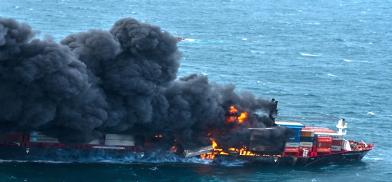An environmental disaster off Colombo: Possible lapses in shipping protocols need investigation
The slow sinking of the fire-stricken Singapore-registered container ship X-Press Pearl off Colombo port, almost on the eve of World Environment Day June 5, has the potential to turn into a major environmental disaster for Sri Lanka and neighbouring India

The slow sinking of the fire-stricken Singapore-registered container ship X-Press Pearl off Colombo port, almost on the eve of World Environment Day June 5, has the potential to turn into a major environmental disaster for Sri Lanka and neighbouring India. This accident, which has resulted in the loss of the ship and its toxic cargo, is a relatively infrequent occurrence, but has important policy related strands for the South Asian region that merit scrutiny.
In 2019, there were 41 incidents worldwide (above 1000 GT – gross tonnage), where there was a total loss of vessels and only two of these related to the Indian Ocean region. The global shipping industry has reported a steady decline in the number of accidents/incidents annually and this is ascribed to improved ship-design and manufacturing ; and adhering to best practices at sea.
However, when accidents occur – as in the case of the X-Press Pearl (XPP) a 36,150 DWT (dead weight tonnage) container vessel that was delivered as recently as February 2021 – the consequences are significant. In this case, given the nature of the cargo – nitric acid, other chemicals and cosmetic related products including plastic resin – the environmental impact off Colombo port will be extensive and long drawn out.
As the audio-visual reportage of the accident has indicated – huge quantities of plastic pellets have inundated the beaches of Sri Lanka along a 50 km stretch and experts fear that the long term impact on sea life will be irreversible.
The XPP had sailed from Malaysia to the UAE and was on its return leg from Jebel Ali port in Dubai to Hazira, India, and then Colombo, before returning to Port Kelang in Malayasia. It is understood from media reports that the crew had noticed a leak from one of the containers after sailing out from Jebel Ali during the passage to the next port in Hamad, Qatar.
There was a plan to return to Dubai to discharge this container, but the operators of the vessel decided to continue onwards. In Hazira, the port authorities refused to discharge the container. The vessel then continued its voyage to Sri Lanka and, given the highly dangerous nature of the cargo, they sought expert assistance that was available at Colombo port. The vessel arrived off the Sri Lankan west coast on May 19.
Regrettably, the fire onboard the XPP spread and inclement weather led to a rapidly escalating pattern from May 20 culminating in the XP touching bottom on June 3. While a detailed investigation will provide for a more informed appreciation and assessment of the causes that led to this major disaster - for Sri Lanka and the regional maritime space that includes peninsular India – some policy issues merit notice.
International shipping protocols for carrying highly dangerous cargo are well documented but it is evident that the implementation needs to be reviewed for lapses. In the case of the XPP why and how the acid leak occurred and the sequence of events leading to the loss of the vessel should call for a rigorous review by the concerned professionals. Lessons learned need to be disseminated and local port / customs authorities encouraged to ensure necessary compliance.
The Indian Ocean Region, from the oil-rich Persian Gulf to the Malacca Straits, is among the most densely traversed sea-lanes in the world and one of its more distinctive characteristics is the demography of the littoral. Socio-economic indicators are very modest and this has been further eroded by the Covid pandemic. Many of the local communities along the entire littoral – from east Africa through southern Asian - are dependent on the sea for their livelihood and any disruption to the normal can be disastrous.
As the XPP disaster has revealed, a low probability exigency has very high consequences. The total damage caused by the spillage of chemicals and fuel on the ill-fated ship to human security and the environmental impact by way of long-term maritime pollution is yet to be estimated. In the interim, the chemical/plastic pollutants from the XPP are causing havoc to the marine life and the complex ecological lattice in a vital part of the Indian Ocean region.
(The writer is Director, Society for Policy Studies (SPS). The views are personal. He can be contacted at cudaybhaskar@spsindia.in)










Post a Comment